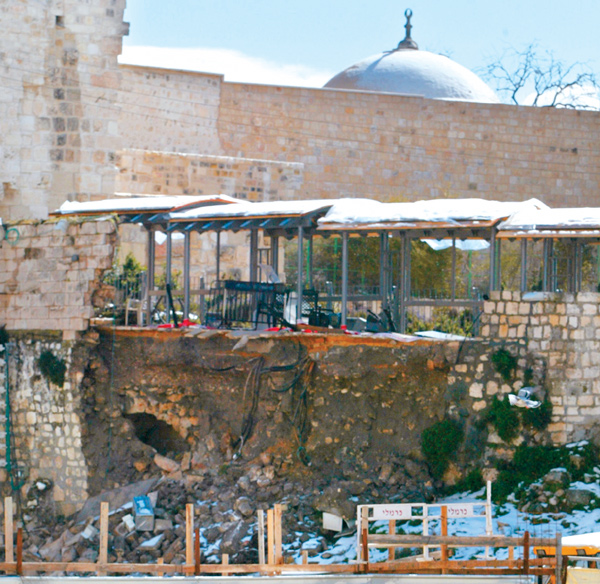How Solid Is the Temple Mount?
IAA Sounds Alarm
010
Jerusalem’s Temple Mount is in danger of collapse, the Israel Antiquities Authority (IAA) told the Knesset, Israel’s parliament, in May. IAA director Shuka Dorfman informed the Knesset’s Interior Committee that the eastern wall of the compound is in danger of immediate collapse, which could cause a domino effect and bring down other parts.
Dorfman’s public warning follows a classified report issued by the IAA in April to the highest levels of Israel’s government and security establishment. According to the Jerusalem Post, the report warned that an earthquake this past February 11 may have damaged the eastern wall of the Temple Mount so badly that parts of it are liable to collapse. The IAA asked government officials to recommend appropriate actions.

The report comes after several earlier signs of trouble. In recent years numerous cracks and a large bulge have formed in the southern wall. The earthquake created new cracks and other signs of instability; most ominously, the 800-year-old wall supporting the ramp that leads up to the Mograbi Gate, the entrance by which non-Muslims visit the Temple Mount, collapsed.
Following the incident, Eilat Mazar, an archaeologist at Hebrew University with long experience excavating at the Temple Mount, sounded the alarm. Attacking the IAA for not sufficiently supervising the Mount, she warned that the entire compound, because it is built on large underground caverns that were already damaged by an earthquake in 1927, is inherently unstable and requires strict supervision. Signs of trouble are everywhere, Mazar complained, and yet the authorities do nothing. “A major collapse at the site, which would cause a major disaster, is only a matter of time,” she told Reuters.
Israeli engineers speculated that the wall collapsed because of the one-two punch of the February earthquake and a heavy snowfall. However, many Israeli archaeologists, most notably Mazar, also blame the Waqf, the Islamic religious institution responsible for maintaining the Temple Mount compound. The Waqf has been performing unsupervised and illegal construction work over the last several years that has, the archaeologists claim, destabilized the Mount.
The Waqf insists that neither its construction work nor the earthquake has caused any damage. The Waqf’s director, Adnan Husseini, told reporters that he did not “understand how [the IAA report] could be issued since there is no problem due to the earthquake.” When the wall at the Mograbi gate collapsed, the Waqf argued that renovations at the nearby Western Wall plaza—the Jewish prayer area—had destabilized the embankment. The terrorist group Hamas went further and accused Israel of trying deliberately to undermine the foundations of the al-Aqsa mosque, on the south side of the Temple Mount and Islam’s third holiest site.
At issue is more than simply the stability of the site. Control over the Temple Mount’s archaeology is at stake. Since the Waqf began its renovation projects, including the construction of an underground 011mosque east of al-Aqsa, there have been allegations that the Waqf is deliberately effacing traces of a historical Jewish presence on the Mount. An Israeli photographer who claims he entered the Temple Mount disguised as a Palestinian recently published pictures of large stones that the Waqf was in the process of removing, stones that, according to Mazar, bear carvings that clearly date them to the Second Temple period (before 70 A.D.). At the very least, the Waqf has been carting off debris rich in ancient archaeological artifacts and dumping it. The Waqf denies everything, and Mazar has denounced the Israeli Antiquities Authority for pretending to “know nothing” and “see nothing.” “What more is needed to prove to the prime minister that the Temple Mount is an ancient site which is in need of professional archaeological supervision?” she asked in the Jerusalem Post.
Between the two sides stand the Jordanians, who are presently at work repairing the bulge in the southern wall. They blame neither the Waqf nor the Israelis, and point instead to the effect of the natural flow of rainwater over the centuries. In April Jordan convened a team of Jordanian and Egyptian engineers, geologists and architects at Jerusalem, where they spent a week running tests on the eastern wall. A report is expected shortly, and given the relations between Israel and the Waqf, Jordanian participation might be the key to shoring up the Temple Mount.
Jerusalem’s Temple Mount is in danger of collapse, the Israel Antiquities Authority (IAA) told the Knesset, Israel’s parliament, in May. IAA director Shuka Dorfman informed the Knesset’s Interior Committee that the eastern wall of the compound is in danger of immediate collapse, which could cause a domino effect and bring down other parts. Dorfman’s public warning follows a classified report issued by the IAA in April to the highest levels of Israel’s government and security establishment. According to the Jerusalem Post, the report warned that an earthquake this past February 11 may have damaged the eastern wall of the […]
You have already read your free article for this month. Please join the BAS Library or become an All Access member of BAS to gain full access to this article and so much more.
